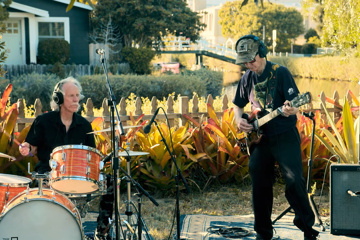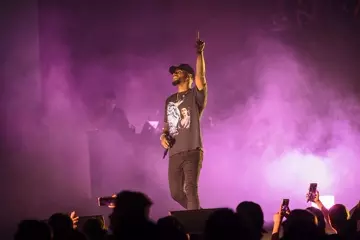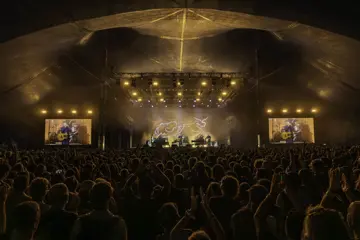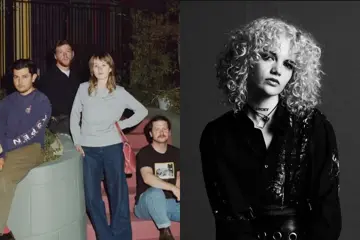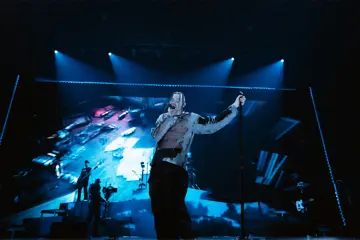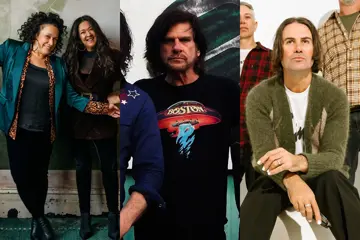Live music and the performing arts are the main driving forces behind the jam-up growth and diversity of Night Time Economies (NTEs) in eleven main cities.
The NTEs are worth $146 billion in sales turnover and account for over a million jobs.
This is from a new report from the Council of Capital City Lord Mayors (CCCLM) of businesses operating 6 pm to 6 am in the 2021/2022 financial year.
The Measuring the Australian Night Time Economy Report showed there were 131,370 core NTE establishments covering Food, Drink and Leisure and Entertainment. They represented a 7 per cent growth on the previous period with the strongest shift in Leisure & Entertainment at 12 per cent, of which half came from creative and performing arts activities.
"The night-time economy is where hospitality, events and accommodation providers really shine, and we are delighted to see Australians continuing to embrace food and entertainment after dark," said CCCLM chair and Lord Mayor of Melbourne, Sally Capp.
"Despite the ongoing external challenges presented by the pandemic and the new rhythms of people travelling in and out of cities, it’s clear that night-time economies are continuing to thrive.”
As of June 2022, there were 20,438 more core NTE businesses than in June 2019, before COVID-19. The 18 per cent upsurge over that time indicated that despite external challenges, the sector remained resilient. The emergence of other NTE sectors showed its diversity, moving from being alcohol-based to safer pursuits.
Since this data was collected, virtually all cities have put NTE plans in process to make it easier for businesses to start and thrive.
Don't miss a beat with our FREE daily newsletter
The report said: “The strongest growth was in the Leisure and Entertainment sub-sector (up 12 per cent or by 4,300), with over half of the increase due to Creative and Performing Arts activities.”
Also posting growth were food businesses, up 4 per cent by 3,400) and those in drinks, which grew 5 per cent. Music, creative and performing arts also drove the drinks sector, which reached 9457 establishments in 2021/22 and sales turnover up by 5 per cent to $21.9 billion.
The major growth was in pubs, taverns and bars, where sales turnover rose by 9 per cent to $12.4 billion. Within this, Leisure and Entertainment jumped 14 per cent to $5.5 billion, with music and creative activities up 22 per cent to $1.3 billion.
Sports and Physical Recreation Activities, in comparison, escalated by 14 per cent to $2.1 billion.
Business Turnover
Core NTE businesses’ sales turnover of $146 billion represented an advance of 10 per cent from 2020/21 and 5 per cent higher than pre-pandemic levels in 2018/19.
But, the report cautioned, “Inflation has increased by 7.6 per cent since the pandemic (4.4 per cent since 2020/21), placing the sector slightly behind 2018/19 in real terms.
Employment in Core NTE was a slight 1 per cent rise between June 2021 and June 2022. But it was 6% lower than in pre-pandemic June 2019. This meant the sector lost 66,000 workers in those three years.
35,000 of those who waved goodbye were from the music and creative sectors. These lost more than 11,000 employees (a fall of 4 per cent) from June 2021 to June 2022.
So why were there fewer people in jobs when sales were escalating? Put it down to the fact that during this time period, businesses were still uncertain about whether to put on more staff, given the changed market conditions at that time, the threat of inflation, and a move towards increased contactless operation.
Or blame a shortage of hospitality staff. Many were left disillusioned because of the uncertainty of their jobs and low wages for long hours, migrant workers and backpackers being locked out of the country, and younger people not interested in doing hospitality. In Darwin, for instance, nightclubs were actually offering up to $100,000 a year to entice workers from the south.
FIVE STATES AND A TERRITORY
We look at the report’s data about six places and their future plans to ensure more people will hum the song “They Only Come Out At Night.”
New South Wales
NSW had the largest absolute increase in Core NTE employment (up by 14,015 or 5 per cent), driven mostly by the Food sub-sector (up 7 per cent), although Core NTE employment remained 14 per cent below 2018/19 levels.
Expect live music’s share to increase by the next report from recent initiatives by the NSW Government. In October and November 2023, it introduced Venues Unlocked to increase the number of live performance venues in NSW. It began its first live music audit and brought in stricter rules on complaints, a two-hour extension on Sundays and more special entertainment precincts.
Sydney had the highest density of night-time establishments per square kilometre in Australia. This upswing was by 17 per cent from pre-pandemic levels to 5,941 with a sales turnover of $4.7 billion. Of these, 1,118 were in Leisure & Entertainment, growing by 14 per cent and sales turnover up by 4 per cent to over $1.2 million.
In comparison, retail businesses only went up by 2 per cent to 2,678, with jobs mushrooming by 7 per cent and turnover to $5.6 billion annually. The number of food joints developed by 4 per cent to 4,088, reporting a 6 per cent increase in turnover to $2.7 million. The number of drink businesses enlarged by 10 per cent to 735, with a 12 per cent increase in turnover to $809 million.
The NSW 24-Hour Economy Commissioner put Sydney’s current NTE worth at $27 billion. The City of Sydney reckons it generates $3.64 billion in revenue each year.
“For years, our communities have told us they want a vibrant night-time city where businesses big and small can flourish,” Lord Mayor of Sydney, Clover Moore, said. “The report highlights an opportunity for businesses to extend, improve or diversify their evening activities to support a more interesting and successful night-time economy.”
The City of Sydney hopes by 2030 to move “from a focus on younger people and drinking to 40 per cent of people being over 40.” The idea is to lift turnover to $30 billion and 100,000 jobs, with 40 per cent of operating businesses to shop.
“We're encouraging a larger variety of retailers and attractions to stay open late, to broaden people's choices of things to do at night.”
Victoria
The number of establishments grew 7 per cent, driven by a 17 per cent increase in Leisure and Entertainment (particularly Creative and Performing Arts, which was up 20 per cent), although many were not employing. The report said, “Turnover increased by 9 per cent, but employment declined 5 per cent in 2020/21, mostly due to job losses in Leisure & Entertainment.”
Melbourne’s NTE’s $3.5 billion contribution to the economy in 2019 had upturned by 12 per cent by April 2023. Again, expect the next report to show an advance in live music’s share.
This comes after the recent advent of a Night Mayor, an NTE committee, the lifting of the freeze on late-night licenses, and a push to attract people at night by demanding that venues that got grants take steps to stop gender-based violence, including sexual harassment.
Queensland
NTE employment remained steady in the 2022 financial year, but there was a marked increase in sales turnover (+16 per cent) due to particularly strong performance in Leisure and Entertainment (+20 per cent). Sales turnover in this activity returned to 2018/19 levels, and Core NTE sales exceeded their pre-pandemic peak.
Brisbane had the sharpest growth of 20 per cent in core NTE sales turnover to $9.5 billion, compared to a 6 per cent rise to $4.7 billion in Sydney because of lockdowns during the period. Brisbane’s drink subsector gained 26 businesses in 2022 (up 10 per cent), of 10 alcohol retailers and 16 bars and pubs.
Western Australia
The state’s employment was up 11 per cent, and sales turnover by 18 per cent compared to 2018/19 throughout the state. City of Perth Lord Mayor Basil Zempilas was enthused by how Perth’s sales turnover was up a staggering 16 per cent on pre-pandemic levels, outpacing the national average.
"The flow-on effect from vibrant streets full of people and activity is jobs,” he stressed. “In a period where making a living has never been harder, we saw a remarkable growth in employment in our city, surpassing pre-pandemic levels by 13 per cent. This easily outperformed national trends.”
Another pleasing outcome, he noted, “has been the diversification of our offerings here in the city. In the 2021/22 period alone, the number of leisure and entertainment establishments grew by 16 per cent, which included an impressive growth in sales turnover of 9 per cent within this night-time economy sub-sector.
"In contrast, the number of drink establishments fell by 8 per cent through that period, which is a clear indicator that the mix of places and experiences in the city to take your family to or meet up with friends after work and on the weekends is changing."
Australian Capital Territory
Employment expanded by 1 per cent and turnover by 11 per cent. Since those figures, there’s been a move to branding Canberra as an after-dark destination. The ACT Government set up a task force to achieve this. Music ACT Director Daniel Ballantyne pointed out Canberra tends to stop at 9 pm with few music venues and theatres still operating.
In July, Music ACT’s third State of The Territory conference brought speakers in to discuss the success of Brisbane’s Fortitude Valley precinct, a researcher of Melbourne’s successful late-night scene, and a Live Music Office chief to suggest opportunities.
South Australia
SA’s Core NTE employment declined by 8 per cent, representing an 11 per cent drop to pre-pandemic levels. Live music played a vital role in diversifying night-time activities and supporting creativity and culture in the city.
In 2021, contemporary music events generated $11 million in revenue and attracted 212,000 attendees. Classical music performances contributed $6 million in revenue with an audience of 77,000 fans. Festivals contributed $25 million to the economy with a draw of 1 million patrons.
Moving forward, in July 2023, the Adelaide Economic Development Agency's Data After Dark briefing presented speakers who pressed home the importance of year-round festivals, cultural precincts, and diverse programs covering music, theatre, art and exhibitions. Mary Poppins sold 100,000 tickets. The Adelaide Festival Centre and Her Majesty’s Theatre draw 1 million people a year, 14 per cent from abroad and 110,000 from interstate.
The branding of Adelaide as a UNESCO City of Music had to be amped, as it was targeting a broader demographic beyond the 18-24 age group, embracing technology to meet changing consumer demands and capitalising on the return of international travel and students.
While music pulled its weight, it was frustrating that one key element of Adelaide’s NTE was not.
The city boasts the highest density of Core NTE, food and drink businesses per residential population. But many are closed from 6 pm to 9 pm – 73 per cent of cafes, 55 per cent of takeaway outlets, 17 per cent of restaurants, and 69 per cent of gyms.


